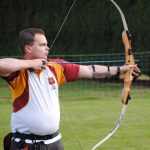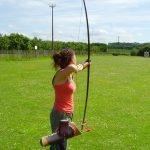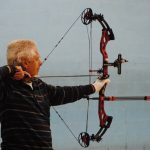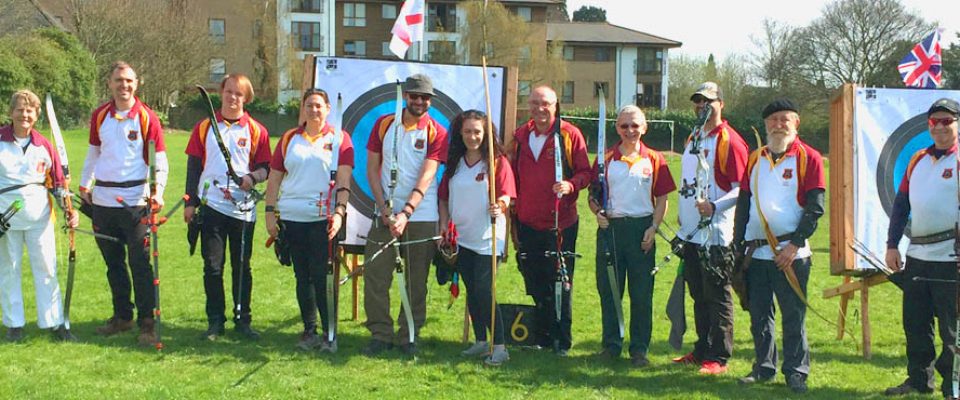Like most sports, archery requires some specialist equipment in order to take part. There are many components ranging in price from a few pound up to thousands of pounds for professional equipment, but do not let that put you off. You can start in archery with just a few basic items and expand as your experience and ability progress. All you really need to get started is a bow, some arrows, a quiver to hold the arrows, a bracer to protect your arm and a tab or release to pull and release the string and a stringer.
Bows

barebow
Recurve and Barebow
There are a few different types of bow. Most people begin with a barebow or recurve bow as these are the most accessible. A barebow is simply a recurve bow without the added accessories of a sight, stabiliser or clicker. As all of these accessories are removable, these two disciplines can be interchangeable and many people start with barebow and move onto recurve as they purchase and add the accessories to their existing bow. Each style has its own way to draw (pull the string) and aim. A recurve bow is usually constructed of three parts, a riser (the middle section incorporating the handle) and the limbs one at each ens of the riser. These are fitted together and strung to form the bow each time you shoot.

longbow
Longbow
Longbows were first recorded in use during battle in 1298 and were a dominant weapon on the battle field until the mid-16th century. The bows are characterized by their simplicity: they consist of a long, slightly curved piece of wood the same height as the archer and do not have arrow rests or sights. Longbows are much more difficult to aim than other modern bows and do not have nearly the same velocity as compound or recurve bows. The longbow requires more practice and patience to master, but many archers enjoy the challenge of learning to effectively use longbows.

compound
Compound
Compound bows were first produced in the 1960s and involve an innovative system of cables, pulleys and eccentric cams that assist the archer in holding a heavy draw weight at full draw. This system gives archers time to aim a powerful bow without causing excessive muscle fatigue. However, a good deal of strength is needed to initially draw the bow. Compound bows are less affected by changes in temperature and humidity than bows made of natural materials, which gives them better accuracy, distance and arrow velocity. Compound bows are typically not used by beginners because of their inherent complexity.
Arrows
There are many different types of arrow made of differing materials. Typical starter arrows are relatively cheap and made of aluminium or fibreglass. Modern arrows incorporate or are wholly made from carbon which helps make the arrow lighter but stronger. Longbow archers generally use wooden shafts as arrows. All arrows require fletches (fins) made of plastic or feathers which help the arrow stay straight along the trajectory towards the target. All arrows have a straightness rating known as the spine of the arrow and this must be matched to the strength of the bow you are pulling. There are many charts that help guide you to the required spine based on your bow strength (the poundage of the bow) and your draw length.
Quiver
A quiver is simply a device designed to hold an archer’s arrows. A side quiver is attached to a belt and worn around the waist, while a ground quiver is placed on or into the ground to hold arrows next to the archer. Some ground quivers can also hold bows when they’re not in use.
Bracer
A bracer is used to keep loose clothing from getting in the way of the string, and to stop the string hitting the arm, which could cause bruising. It is fitted to the inside of the arm holding the bow, between the elbow joint and the wrist. The widest end of the bracer fits closest to the elbow.
Tab / Release
A tab provides protection for the fingers which draw the string. For a close and comfortable fit they are secured over the archer’s fingers, and some models can be adjusted to the size of your hand. They are made from a patch of leather which goes between your fingers and the string.
A release is used by compound archers to hold the string and releases the string when you pull a trigger. There are many different versions and it is best to try them out before buying to see what suits you best.
Stringer
A bow stringer is used to string and unstring a bow. For your own safety it is always best to learn to do this under the guidance of an experienced archer or coach and you will learn this basic skill on any beginner course. Compound archers do not require a stringer as they do not unstring their bow each time they use it.
Rest and Button
An arrow rest is a simple device that fits to the riser of the bow to support an arrow while it is being shot. It is designed to hold the arrow in the correct position, and is flexible enough not to interfere with the arrow as it begins its flight. Arrow rests are available for left- and right-handed bows.
A button works in conjunction with a rest to help hold the arrow in the correct position during the release of the arrow.
Stand
A stand is used to store the bow at the shooting line between rounds.


